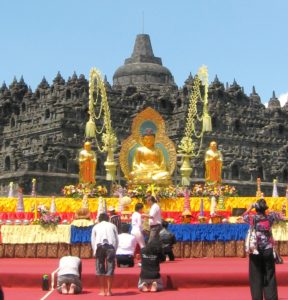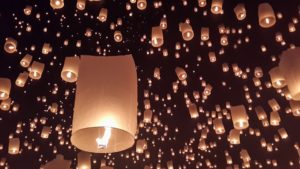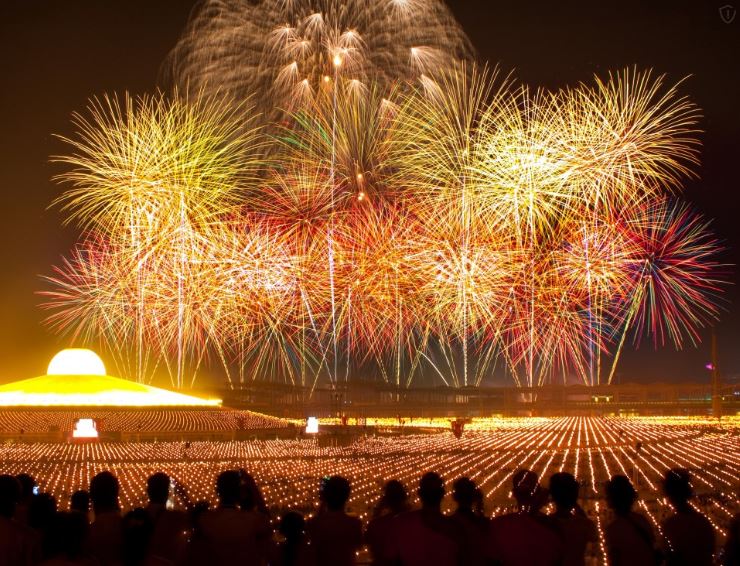Buddhism is an ancient religion that is practiced all around the world, mostly in Asian countries. Most religions have celebrations, holy days, and days of commemoration. Buddhism is no different. Like Christianity, the ways of celebrating vary by region and ethnic origin.
Buddhist New Year
Just like other religious calendars, the Buddhist New Year begins at different times in different countries. In the Theravadin countries (Thailand, Burma, Sri Lanka, Cambodia, Laos), it is celebrated for three days starting with the first full moon in April. In the Mahaya countries (India, Japan, Singapore, Taiwan, Nepal, Tibet, Bhutan, Mongolia), the New Year begins on the first full moon in January. China, Korea, and Vietnam (also Mahaya), however, follow the lunar calendar and begin festivities in late January or early February.
Vesak (or Visakah Puja, meaning “Buddha Day”)
 One of the most important days in Buddhist life, Buddha Day focuses on the three main times in Buddha’s life – his birth, his enlightenment, and his death. It is celebrated on the first full moon in May, but this is changed to June during leap years. People decorate their homes and give offerings of food, candles, and flowers to the monasteries.
One of the most important days in Buddhist life, Buddha Day focuses on the three main times in Buddha’s life – his birth, his enlightenment, and his death. It is celebrated on the first full moon in May, but this is changed to June during leap years. People decorate their homes and give offerings of food, candles, and flowers to the monasteries.
Magha Puja Day (Fourfold Assembly, or “Sangha Day”)
During the first full moon in March, the second most important festival takes place. It commemorates the time when 1250 Arahats (enlightened saints) gathered at the Veruvana Monastery to hear Buddha preach. It is called the Fourfold Assembly because it consisted of four factors: There were 1250 Arahats in attendance; all of them were ordained by Buddha himself; they assembled without being told to, and it happened on the full moon day of Magha month (March). It is a time for exchanging gifts and reaffirming one’s commitment to Buddhism.
Asalha Puja Day (“Dhamma Day”)
On this day, Buddhists pay homage to Buddha on full moon day of the eighth lunar month (usually July). It marks the beginning of Buddha’s first teaching (the turning of the wheel of the Dhamma). It is usually celebrated with readings of Buddha’s scriptures.
Uposatha (Observance Day)
This takes place on four monthly holy days observed in Theravada countries (the new moon, the full moon, and both quarter moon days). In Sri Lanka, it is called Poya Day.
Pavarana Day
This occurs at the conclusion of the Rains retreat (Vassa). On the following month, the Kathina ceremony, where the laity gathers to make formal offerings of robe cloth and other requisites to the Sangha, begins.
Kathina Ceremony (Robe Offering Ceremony)
The ceremony is held on any convenient date within one month of the conclusion of the Vassa Retreat (that’s the three months Rains Retreat season {Vassa} for the monastic order). It’s the time of year when new robes and other requisites may be offered by the laity to the monks.
Anapanasati Day
At the end of one Rains Retreat (Vassa), the Buddha was so pleased with the progress of the assembled monks that he encouraged them to extend their retreat for yet another month. On the full moon day marking the end of that fourth month of retreat, he presented his now-famous instructions on mindfulness of breathing (anapanasati).
Abhidhamma Day
The Burmese celebrate the occasion when Buddha is said to have gone to the Tushita Heaven to teach his mother the Abhidhamma. It is held on the full moon of the seventh month of the Burmese lunar year (this year starts in April and it corresponds to the full moon day in October).
Songkran
This Thai Buddhist festival lasts for several days in the middle of April. People celebrate by cleaning their houses and washing their clothes. They enjoy sprinkling perfumed water on the monks, novices and other people for at least two or three days. Then they gather around the riverbank, carrying as much fish as they can carry in jars to put back into the water. That’s because April is so hot in Thailand that the pond dries out and the fish would die if not rescued. People go to the beach or riverbank with jars or buckets of water and splash each other until everyone is happily wet. The day usually ends with boat races on the river.
Loy Krathong (Festival of Floating Bowls)
 The Loy Krathong Festival takes place in all parts of Thailand on the full moon night of the Twelfth Lunar month right at the end of the Kathina Festival season. People bring bowls made of leaves (which contain flowers, candles, and incense sticks), and float them in the swollen rivers and canals. They believe that as the bowls float away, all bad luck is supposed to disappear. These traditional practices are meant to pay homage to the holy footprint of the Buddha on the beach of the Namada River in India.
The Loy Krathong Festival takes place in all parts of Thailand on the full moon night of the Twelfth Lunar month right at the end of the Kathina Festival season. People bring bowls made of leaves (which contain flowers, candles, and incense sticks), and float them in the swollen rivers and canals. They believe that as the bowls float away, all bad luck is supposed to disappear. These traditional practices are meant to pay homage to the holy footprint of the Buddha on the beach of the Namada River in India.
The Ploughing Festival
This is the celebration of Buddha’s first moment of enlightenment, which is said to have happened when the Buddha was seven years old when he had gone with his father to watch the ploughing. The festival takes place in May when the moon is half-full. The main event has two white oxen pull a gold-painted plough, followed by four girls dressed in white, who scatter rice seeds from gold and silver baskets. In Thailand, it is called Raek Na.
The Elephant Festival
”The Buddha used the example of a wild elephant which, when it is caught, is harnessed to a tame one to train.” (www.buddhanet.net) The quote basically means a person who is new to Buddhism should seek an older, more experienced Buddhist for guidance and teaching, thereby attaching himself to the “tame elephant.” It is held on the third Saturday in November in Thailand.
The Festival of the Tooth
In the Sri Lankan city, Kandy sits a great temple that was specially built to house a relic of the Buddha – his tooth. Since the tooth can never be seen, as it is kept deep inside many caskets, there is a special procession for it that occurs once a year in August, on the night of the full moon.
Ulambana (Ancestor Day)
In the Mahayana tradition, Ancestor Day is celebrated from the first to the fifteenth days of the eighth lunar month. On the first day, the gates of Hell open and ghosts visit the world for fifteen days while the living offer food to the ghosts. On the fifteenth day (Ulambana or Ancestor Day), people visit cemeteries to make offerings to their departed ancestors. This is also practiced in Cambodia, Laos, and Thailand. In Japan, it is known as Odon, and begins on the thirteenth of July and lasts three days.
Avalokitesvara’s (Kuan Yin) Birthday
This is a festival that celebrates the Boddhisattva ideal as represented by Avalokitesvara, who represents the perfection of compassion in the Mahayan traditions of Tibet and China. It begins on the full moon day in March.
Parinirvana Day
In the Mahayana tradition, Parinirvana Day (or Nirvana Day) marks the day of Buddha’s death. People commemorate this festival by visiting the monasteries and Buddhist temples. Some just meditate. The celebrations vary by country.
Losar
This is the most important festival in Tibet and marks the beginning of the Tibetan New Year. For three days in February every year (depending on the lunar calendar), people exchange gifts, visit monasteries, and feast.





